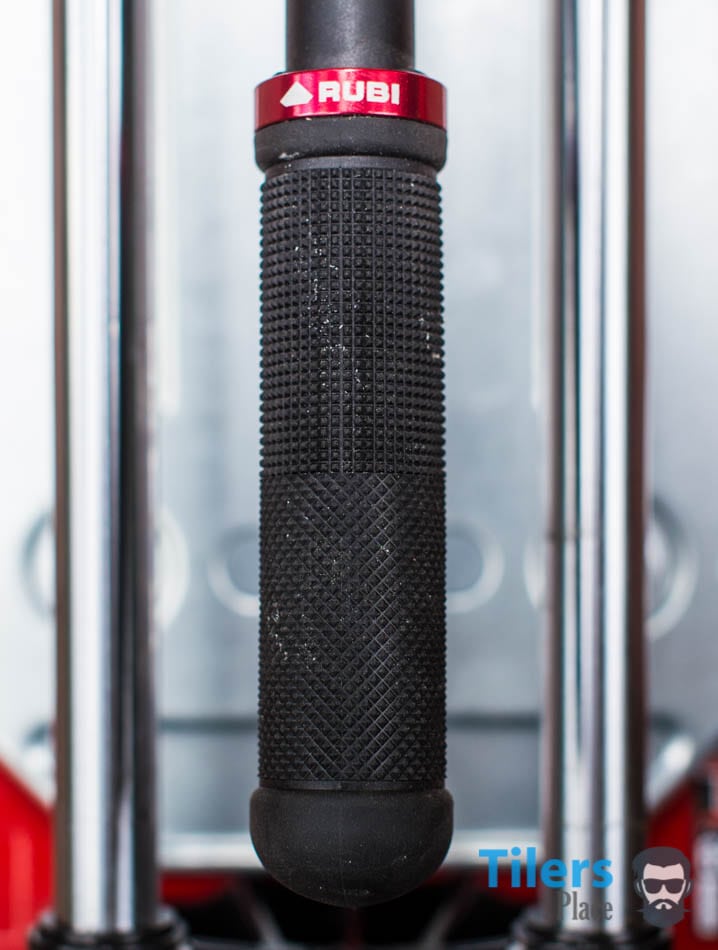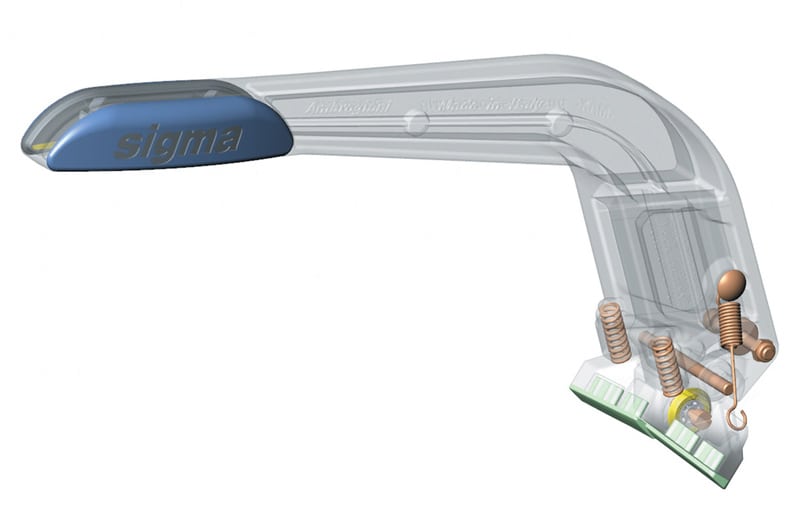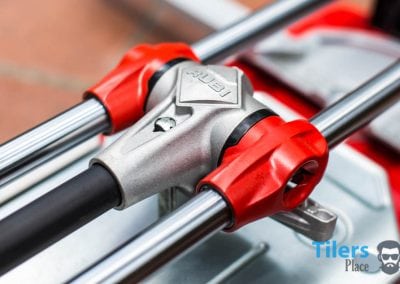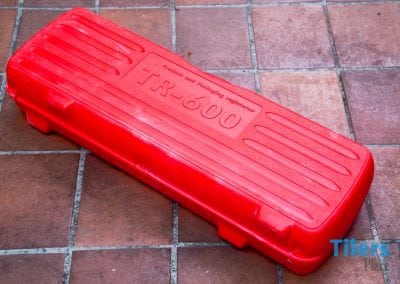Table Of Contents
Rubi Tools – TR-600 Magnet Tile Cutter
Full In-Depth Review
I review the new TR-600 Magnet Tile Cutter made by Rubi Tools to see if it lives up to the high standards that Rubi manual tile cutters have set in the past.
It’s the latest update in the Rubi TR-S tile cutter line featuring 200kgs more breaking power in the same sized package and a revolutionary new Magnet system that allows for one-handed operation.
Are the new features game changers or mere gimmicks to sell more tile cutters?
The Rubi TR-Magnet will take on the gruelling task of being my main snap and score tile cutter as I find out if these features live up to the task of making it a true professionals tile cutter.
Will the Rubi TR-Magnet handle the pressures of the job or will it be crushed beneath them like a cheap QEP Tile Cutter?
Read on and find out as I take the Rubi TR-Magnet to work!

Rubi TR-MAGNET Tile Cutter Quick Specs:
Rubi TR-Magnet 600 Manual Tile Cutter
Rubi TR-Magnet 710 Manual Tile Cutter
- Cutting length – 60 cm (24inches)
- Diagonal cutting length – 42×42 cm (17×17 inches)
- Cutting height – 3-15 mm (5/8”)
- Separator power – 800 kg (1764lbs)
- With carrying case – YES
- Weight: 10 KG (22lbs)
Rubi TR-MAGNET Tile Cutter FEATURES:
- One piece alloy ruler bar
- Ability to cut ceramic, porcelain and mosaic tile.
- Moving breaking system – great for diagonal cuts
- Sprung base with built-in shock absorption
- Repetitive angular cuts from 0 to 45° both ways
- Direct view of the cutting and scoring line
- Fold out outrigger arms support larger tiles
- 5-year guarantee
- Soft grip handle.
- Reinforced components result in increased breaking power.
- Built-in central pivot swivel square for quick and precise measurement of angular cuts in the -45º to 0° to 45° range.
- Solid steel guides- chromed and rectified, with anti-corrosion treatment for greater resistance to bending and increased reliability.
- Lateral stop for repetitive cuts – set a size and go.
- Interchangeable scoring wheels available between Ø 6mm -22mm for all types of tiles.
- High-strength aluminum base.
What all this means:
All these features boil down to this, this porcelain tile cutter will cut accurately day in and day out.
Today, tomorrow, next year.
You can trust that it will cut your tiles perfectly straight and if you set a size, you can rip how many tiles you need to that set dimension.
It will cut any porcelain tile you encounter without taking chips out of the glaze and breaking it into pieces.
This is a tool for tiling professionals.
You are paid to do the very best job and so your tools need to reflect this.
There is a very strong reason why these Rubi manual tile cutters are priced the way they are. You are paying for the utmost standard of quality that will keep on performing for years to come.
Do not be fooled by the countless tile cutters listed at Amazon that sell for $100-200 as they are made with the cheapest of materials and mass produced in China or Taiwan.
Any of those tile cutters will not last a month of use and the fact some say that they are professional tile cutters is simply ridiculous.
Rubi TR-MAGNET Tile Cutter Pros/Cons
Pros:
• One-Handed Operation
• Powerful enough to cut any ceramic and porcelain tile
• Easily cuts anything from the smallest subway tile to a large format porcelain
• Moving breaker bar ensures higher success rate for tricky cuts
• Exceptional build quality and design.
• It’s not just a ceramic tile cutter. It’s also a porcelain tile cutter, perfect for tough, modern tiles.
• NOT MADE IN CHINA!
Cons:
• Size – with the swinging crossbar it takes up a lot of room in the work area.
• Weight – lugging it out of the work truck every morning is never fun.
Seriously, the con section is almost comical in this review as there aren’t any real ones.
All the cons are reflective of this tile cutters abilities.
It needs to be large in order to fit large tiles and it has to be built of powerful metals in order to produce the 800kg breaking strength which makes it heavy.
These things are just the price we pay to have the very best porcelain tile cutter, no one ever said tiling is easy and heavy lifting is just par for the course of this business.
Rubi TR-600 MAGNET Tile Cutter Review
Out With the Old – Retiring my Rubi TS-50 Tile Cutter
Even the best tools need to be retired at some point, either they stop being as effective as they once were, the materials have worn away, or you simply want to try something new for a change.
For me, it was all those things.
I had been using the Rubi TS line of ceramic tile cutters for over 10 years as my main ceramic/porcelain tile cutter for small tiles under 50cm’s in length.
Anything from ceramics, mosaics and porcelain felt the Spanish precision of my tile cutter as I used them day in and out for thousands of tiling jobs.
I was never let down by the simple yet effective ceramic tile cutters that were as robust as they were effective and when one reached retirement, I went and purchased a new one.
As old as the TS-line of snap and score tile cutters is, the design has managed to keep up with every-changing tile trends and materials, and even though tiles have gotten thicker and tougher, the Rubi TS still managed to snap em cleanly.
So when it was time to retire my latest Rubi TS-50 tile cutter, my initial plans were to simply get a new one.
My Rubi Star tile cutter that I had previously reviewed got sold to a buddy after he fell in love with the thing on one job. Coming from a former Montolit fan-boy, it was a welcome surprise to see him enjoying the Rubi tile cutter.
So with only my Rubi TX-900-N left in the stable, I needed a small tile cutter to handle those merciful jobs that didn’t involve large format tiles.
First Impressions of the Rubi TR Magnet Tile Cutter
Long Term use of the Rubi TR Magnet Tile Cutter
The Weeks Goes By And I Learn Some Tricks.
Over the coming weeks and months, I experienced cutting a myriad of different tiles with the Rubi TR-Magnet tile cutter and learned how to get the most out of it. The main thing I learned is that this is a very powerful porcelain tile cutter and that super-sized handle can very easy pulverize smaller tiles while scoring them. You do not need to lean so hard on it during scoring, your scoring strength is dramatically increased thanks to the length of the handle, so you can go easier on it during scoring. This is prudent to remember, especially when cutting subway tiles or 12×12 inch porcelain tiles or smaller. This change in scoring was by far the biggest change and skill I needed to learn during my initial training with the new porcelain tile cutter. After that, it was smooth cutting all the way. On one job I was brazen enough to try cutting heavily textured 12×24 tiles, something I usually left to my handheld tile saw. You know what? It did great. I scored the tile a few times to make sure I got into every crevice, dropped the handle and boom, beautiful straight cut. Instantly my work speed had doubled since now I didn’t have to make every cut manually on the handheld tile saw. The Rubi TR-Magnet ceramic tile cutter was quickly paying for itself.
But Can It Cut Full 24 Inch Tiles?
I don’t know about the tile trends that are currently the next big thing in your area, but I bet you have laid your fair share of 24inch (60cmx60cm) tiles since they first arrived on the scene.
Personally, I hate these things and need to have a word with the designer who thought oversize tiles should be the next big trend in tiles.
Once the full 24-inch tile hit the market, they opened the floodgate for all manner of large format porcelain tiles that kept getting bigger and more ridiculous as the years moved on.
Now there are tiles don’t won’t fit into the bed of my Ram pickup, and if something can’t fit into the back of a full-size pickup truck, you know you’ve gone overboard.
I’m lucky enough to work mainly with the “smaller” 24-inch tiles in the jobs that I do and so tile cutters like the Rubi TX-900-N is more than adequate for those and slightly bigger tiles.
Since I already own a tile cutter for large format porcelain tiles, I never even thought I should use my Rubi TR-Magnet to cut 24-inch tiles.
I used it for the common 12×24 inch tiles and it worked great every time but for some reason, I never did the obvious thing and tried a full-size tile.
That all changed when one day I was simply too lazy to lug out my heavy Rubi TX-900 from the truck and instead took the Rubi TR Magnet.
Set it up, slid a full 24-inch tile in and surprise surprise, it fit great! The support arms on the side of the cutter also helped stabilize the bulk and kept it steady during a cut.
Speaking of the cut; it did it great!
The TR-Magnet excels at cutting thick, tough tile really well. I think it cuts thick tile better than it cuts thin tile which sounds funny but it’s true.
You can imagine my surprise when my medium sized tile cutter was slaying these 24-inch tiles without any problem. And this wasn’t a one-off thing either, I completed over 100 square feet of 24 inch tiles only using the TR-Magnet 600.
After that revelation, I used it for more jobs involving 24-inch tiles and it performed just as well.
This tile cutter has severely reduced the workload of my TX-900 as it can cut such large tiles that only the TX-900 could cut before.
So if you are looking for a tile cutter for 24 inch tiles or a tile cutter for large format porcelain tiles, definitely consider the Rubi TR-Magnet.
It’s smaller size compared to other porcelain tile cutters will make working in cramped conditions much easier, won’t be such a burden to carry around and most importanly; it can cut 24 inch tiles effortlessly!
Rubi Tile Cutters Vs Sigma Vs Montolit Tile Cutters
If you are new to professional tile cutters and are thinking about taking the plunge and investing, I want to tell you why I personally prefer Rubi tile cutters.
In the professional tile cutter game, there are three main players: Rubi Tools, Sigma and Montolit tile cutters.
I see it as a battle of Chevy vs Ford vs Ram pickups. Everyone has their favorite preference as the unique features of every brand best suit them for their ceramic cutting tool of choice.
Some guys like barbeque sauce, some like ketchup while others swear by chilli sauce.
It’s all personal preference.
In saying that, there are some guys that use both Sigma or Montolit and Rubi tile cutters, using different sized models for different tiles. I raise my hats to you legends, you are going beyond brands and getting a quality job done.
Anyway, what I’m trying to do is show you some positives of why Rubi Tile Cutters are my secret sauce in the tiling game and why I believe you will benefit from adding one to your bag of tricks.
Yeah, and pigs fly and I will become Governor of Georgia State. Sure.
Just do your best to ignore those sites as I truly doubt they ever actually cut a tile with a tile cutter, let alone seen one, apart from pictures online.
The ranting aside, with experience using Rubi, Sigma and Montolit tile cutters, why did I end up choosing Rubi as my tile cutter of choice?
There are a few reasons:
The tile cutter handles.
Unlike both Sigma and Montolit that feature a single rail and a bent handle that both scores and breaks, I found the straight handle of the Rubi tile cutters to offer the best all-day comfort.
If you find yourself with a large job and are cutting tiles all day, every day, the strain of scoring and snapping tiles ends up in your wrist, to the point where you can’t move it anymore.
This is especially pronounced with thick tiles that are tough to break, forcing you to squeeze the handle and center rail together to even get the thing to pop.
If you are doing that all day, even a cyborg with titanium steel wrists will begin to feel the strain.
I was subbing with a guy that had a couple of Sigma’s and we were tiling the whole entire reception area, bathroom and utility rooms of a heliport.
There were cuts aplenty, especially in the long corridors and in the bathrooms.
Well, after a week of that my wrist had it and I was in the hospital getting my wrist x-rayed.
“Your a sissy Carl, go deliver papers if you can’t handle the strain!”
I can hear you yelling it at your PC’s and smartphones while reading this and trust me, I was thinking the same thing.
Even my wife said it for Pete’s sake!
Guess what, I found myself using a Sigma tile cutter a few months later and the same problems resurfaced.
I couldn’t play the banjo for a while after that, life lost its lustre.
Feeling like an idiot, I chatted up the guys at tile stores and other fellow tilers and asked them if they had any issues with the crooked handles of the Sigma and Montolit tile cutters.
While the younger guys said they didn’t mind so much, the more experienced grey-hairs were nodding in agreement and pointed out those crooked handles.
As it turns out, the crooked handle forces a different angle on your wrist and makes it do more work than if you were using the straight handle of the Rubi tile cutters.
The handle on the Rubi tile cutters allows your arm to do the heavy work while your wrist simply guides it.
So if you are scoring tiles or snapping thick porcelains, a lot of that strain is removed from your wrist as it’s left straight and out of the tension point.
After 25 years of using Rubi ceramic and porcelain tile cutters, I can honestly say I have never had problems with a sore wrist or arm from using them.
Less Complicated over Sigma, Montolit Tile Cutters.

The Cutting Blades of Rubi Tile Cutters.
All of Rubi’s ceramic and porcelain tile cutters (excluding the TP-S) make use of their patented scoring blades.
These are specially machined rods that slot into a Rubi tile cutters handle section and tightened in place. The scoring wheel is made from hardened tungsten carbide and can score the surface of any tile including glass.
This versatility is what separates Rubi tile cutters from everyone else.
QEP, Brutus, Sigma and Montolit all use only one type of carbide wheel that screws into the handle and has to cut everything.
Rubi Tools understand that there is a myriad of tiles out there and making a tile cutter for ceramic cutting only just wouldn’t do for the inventor of the tile cutter.
Conclusion – The Rubi TR-Magnet Tile Cutter
RUBI TR-Magnet Tile Cutter Picture Galley
Rubi TR-Magnet Tile Cutter (20)
Old and new. The TR-Magnet saying hello to the TS-50 ceramic tile cutter.
Rubi TR-Magnet Tile Cutter (17)
Old cermaic tile cutter sitting next to the new porcelain tile cutter.
Rubi TR-Magnet Tile Cutter (23)
Angled cut with the side stop set for multiple cuts of the same size.
Rubi TR-Magnet Tile Cutter (2)
The Rubi TR-Magnet porcelain tile cutter uses TS,TR,TF scoring blades, same as the old TS-50 ceramic tile cutter.
Rubi TR-Magnet Tile Cutter (15)
Down the sites of the twin rail scoring system on the Rubi TR-Magnet porcelain tile cutter
Rubi TR-Magnet Tile Cutter (22)
The Rubi TR-Magnet porcelain tile cutter ready to snap a tile after it scored it.


































I’ve been using the Rubi Tr-Magnet for over a month now and I gotta say Carl, your review was spot on.
It was the first tile cutter I purchased online from a review and I’m glad I did!
I’m loving the magnet handle, it really makes cutting any type of tile a breeze in comparison to the old TR’s, just a great evolution. Thanks a lot for the thoroughly entertaining and insightful review, your site is an true asset to the tiling world, haven’t found any other site like it.
Keep up the hard work Carl and thanks for the recommendation! So happy I have the Rubi Magnet 🙂